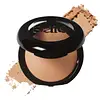What's inside
What's inside
 Key Ingredients
Key Ingredients

 Benefits
Benefits

 Concerns
Concerns

 Ingredients Side-by-side
Ingredients Side-by-side

Mica
Cosmetic ColorantSqualane
EmollientJojoba Esters
EmollientHectorite
AbsorbentOctyldodecanol
EmollientSilica
AbrasiveEthylhexylglycerin
Skin ConditioningPotassium Sorbate
PreservativeCellulose
AbsorbentBoron Nitride
AbsorbentAlumina
AbrasiveGlycerin
HumectantSodium Acetylated Hyaluronate
HumectantWater
Skin ConditioningGlycyrrhiza Glabra Root Extract
BleachingSodium Benzoate
MaskingTocopherol
AntioxidantTin Oxide
AbrasiveCI 77491
Cosmetic ColorantCI 77492
Cosmetic ColorantCI 77499
Cosmetic ColorantCI 77163
Cosmetic ColorantCI 15850
Cosmetic ColorantCI 19140
Cosmetic ColorantMica, Squalane, Jojoba Esters, Hectorite, Octyldodecanol, Silica, Ethylhexylglycerin, Potassium Sorbate, Cellulose, Boron Nitride, Alumina, Glycerin, Sodium Acetylated Hyaluronate, Water, Glycyrrhiza Glabra Root Extract, Sodium Benzoate, Tocopherol, Tin Oxide, CI 77491, CI 77492, CI 77499, CI 77163, CI 15850, CI 19140
Mica
Cosmetic ColorantKaolin
AbrasiveZinc Stearate
Cosmetic ColorantOctyldodecyl Myristate
EmollientBis-Diglyceryl Polyacyladipate-2
EmollientCI 77492
Cosmetic ColorantBoron Nitride
AbsorbentMagnesium Myristate
Microcrystalline Cellulose
AbsorbentCI 77491
Cosmetic ColorantCI 77499
Cosmetic ColorantDimethicone
EmollientEthylhexylglycerin
Skin ConditioningTrimethylsiloxysilicate
EmollientParfum
MaskingSorbic Acid
PreservativeAluminum Hydroxide
EmollientCI 15850
Cosmetic ColorantTocopherol
AntioxidantHelianthus Annuus Seed Oil
EmollientLinalool
PerfumingCitronellol
PerfumingCI 19140
Cosmetic ColorantCI 42090
Cosmetic ColorantCI 77007
Cosmetic ColorantCI 77742
Cosmetic ColorantCI 77891
Cosmetic ColorantMica, Kaolin, Zinc Stearate, Octyldodecyl Myristate, Bis-Diglyceryl Polyacyladipate-2, CI 77492, Boron Nitride, Magnesium Myristate, Microcrystalline Cellulose, CI 77491, CI 77499, Dimethicone, Ethylhexylglycerin, Trimethylsiloxysilicate, Parfum, Sorbic Acid, Aluminum Hydroxide, CI 15850, Tocopherol, Helianthus Annuus Seed Oil, Linalool, Citronellol, CI 19140, CI 42090, CI 77007, CI 77742, CI 77891
Ingredients Explained
These ingredients are found in both products.
Ingredients higher up in an ingredient list are typically present in a larger amount.
Boron Nitride is compound consisting of boron and nitrogen. It is used to absorb oil and modify adherence/ slip in products.
This means it is often used in makeup products to help them last longer.
Ci 15850 is the pigment color red. It is an azo dye and created synthetically.
Azo dyes need to be thoroughly purified before use. This allows them to be more stable and longer-lasting.
This ingredient is common in foundations, lipsticks, and blushes. This color is described as brown/orangey red.
It has many secondary names such as Red 6 and Red 7. According to a manufacturer, Red 6 usually contains aluminum.
Learn more about CI 15850CI 19140 is also known as Tartrazine. Tartrazine is a synthetic dye used in cosmetics, foods, and medicine to add a yellow color.
Tartrazine is created from petroleum and is water-soluble.
Some people may experience allergies from this dye, especially asthmatics and those with an aspirin intolerance.
Learn more about CI 19140Ci 77491 is also hydrated iron III oxide. It's sole purpose is to give a red/pink hue to products.
Iron III oxides are classified as inorganic chemicals for coloring.
Synthetically created Ci 77491 is considered safer than those naturally found. This is because the synthetically created version may contain less impurities. Iron oxides are generally non-toxic and non-allergenic.
Learn more about CI 77491Ci 77492 is also hydrated iron III oxide. It's sole purpose is to give a yellow hue to products.
Iron III oxides are classified as inorganic chemicals for coloring.
Synthetically created Ci 77492 is considered safer than those naturally found. This is because the synthetically created version may contain less impurities. Iron oxides are generally non-toxic and non-allergenic.
Learn more about CI 77492Ci 77499 is also hydrated iron III oxide. It is created from mixing red and black iron oxides. This helps give shades of darkness to a product.
Iron III oxides are classified as inorganic chemicals for coloring.
Ethylhexylglycerin (we can't pronounce this either) is commonly used as a preservative and skin softener. It is derived from glyceryl.
You might see Ethylhexylglycerin often paired with other preservatives such as phenoxyethanol. Ethylhexylglycerin has been found to increase the effectiveness of these other preservatives.
Mica is a naturally occurring mineral used to add shimmer and color in cosmetics. It can also help improve the texture of a product or give it an opaque, white/silver color.
Serecite is the name for very fine but ragged grains of mica.
This ingredient is often coated with metal oxides like titanium dioxide. Trace amounts of heavy metals may be found in mica, but these metals are not harmful in our personal products.
Mica has been used since prehistoric times throughout the world. Ancient Egyptian, Indian, Greek, Roman, Aztec, and Chinese civilizations have used mica.
Learn more about MicaTocopherol (also known as Vitamin E) is a common antioxidant used to help protect the skin from free-radicals and strengthen the skin barrier. It's also fat soluble - this means our skin is great at absorbing it.
Vitamin E also helps keep your natural skin lipids healthy. Your lipid skin barrier naturally consists of lipids, ceramides, and fatty acids. Vitamin E offers extra protection for your skin’s lipid barrier, keeping your skin healthy and nourished.
Another benefit is a bit of UV protection. Vitamin E helps reduce the damage caused by UVB rays. (It should not replace your sunscreen). Combining it with Vitamin C can decrease sunburned cells and hyperpigmentation after UV exposure.
You might have noticed Vitamin E + C often paired together. This is because it is great at stabilizing Vitamin C. Using the two together helps increase the effectiveness of both ingredients.
There are often claims that Vitamin E can reduce/prevent scarring, but these claims haven't been confirmed by scientific research.
Learn more about Tocopherol